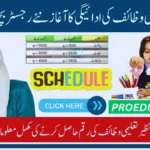Three new matric student groups are introduced by Punjab, providing a variety of educational choices. Learn the features, information, and frequently asked questions in this comprehensive guide.
Education is essential to the advancement of society because it shapes the future generation of leaders and innovators. Punjab Introduces Three New Groups for Matric Students were recently introduced by Punjab’s education board, marking a substantial change. This choice represents a change toward a more specialized and inclusive curriculum that aims to give pupils the tools they need to succeed in the modern world. We’ll go into great detail about these developments in this post, including how they might affect society and students.
Overview of the Education System in Punjab
Punjab has a strong educational system that has undergone substantial change over time. Students choose their academic and career paths during the crucial matriculation stage, which is equivalent to grade 10. The addition of three new groups adds a layer of diversity and specialization to the scientific and arts streams that students could previously pick from. This shift emphasizes skill development and practical knowledge, which is in line with worldwide educational trends.
What Are the Three New Groups for Matric Students?
Three separate categories have been introduced by the Punjab Education Board:
- Science and Technology: emphasizes areas related to science, technology, engineering, and mathematics (STEM).
- Arts and Humanities: focuses on social sciences, cultural studies, and creativity.
- Business and Commerce: equips students for careers in commerce, entrepreneurship, and finance.
Every group is made to accommodate certain hobbies and professional goals, enabling students to have a strong foundation in the sector of their choice.
The Importance of Curriculum Diversity
Diverse curriculum are essential for:
- Encouraging Exploration: Early on, students might find their passions.
- Reducing Dropout Rates: Customized classes increase student engagement.
- Bridging Skill Gaps: helps pupils meet the needs of the industry.
This strategy promotes social and economic advancement in addition to helping individuals.
Benefits of Introducing New Groups
For Students
- Personalized Learning: Students might concentrate on their strengths or interests.
- Career Readiness: provide useful information for future employment.
- Boosts Confidence: Gaining proficiency in a particular skill boosts one’s self-esteem.
For Society
- Skilled Workforce: Addresses industry-specific skill shortages.
- Cultural Growth: Promotes arts and humanities.
- Economic Development: Encourages entrepreneurship and innovation.
Group 1: Science and Technology
This group is tailored for students with an aptitude for STEM fields. Key features include:
- Subjects Offered: Physics, Chemistry, Mathematics, Computer Science.
- Career Pathways: Engineering, IT, healthcare, and research.
- Practical Training: Labs and projects to enhance hands-on learning.
This group aims to prepare students for high-demand, tech-driven careers.
Group 2: Arts and Humanities
Focusing on creativity and cultural understanding, this group offers:
- Subjects Offered: History, Literature, Psychology, Fine Arts.
- Career Pathways: Journalism, teaching, social work, and more.
- Skill Development: Critical thinking, communication, and empathy.
By nurturing creativity, this group contributes to a well-rounded education.
Group 3: Business and Commerce
Designed for future entrepreneurs and business leaders, this group includes:
- Subjects Offered: Accounting, Economics, Business Studies, Marketing.
- Career Pathways: Finance, entrepreneurship, corporate roles.
- Entrepreneurial Focus: Encourages innovative thinking and problem-solving.
This group aligns with the increasing global emphasis on business acumen.
How These Groups Prepare Students for Careers
Each group is strategically designed to align with industry needs. Key aspects include:
- Internships and Practical Training: Collaborations with local industries.
- Mentorship Programs: Guidance from professionals.
- Skill Certifications: Recognition of specialized skills.
Comparison with Previous Curriculum Options
| Feature | Previous Curriculum | New Groups |
|---|---|---|
| Specialization | Limited | Enhanced |
| Career Orientation | Basic | Advanced |
| Practical Exposure | Minimal | Extensive |
| Student Engagement | Moderate | High |
The new groups clearly offer a more dynamic and student-focused approach.
Integration of LSI Keywords
The curriculum incorporates natural language processing techniques, making it relatable and efficient. Terms like “personalized learning,” “career pathways,” and “skill development” are seamlessly integrated into teaching methodologies.
Challenges and Solutions in Implementation
Challenges
- Teacher Training: Ensuring educators are equipped to handle new subjects.
- Infrastructure: Upgrading facilities to accommodate specialized labs.
- Awareness: Informing parents and students about the new groups.
Solutions
- Workshops and Seminars: Regular training for teachers.
- Government Funding: Allocating resources for infrastructure development.
- Community Outreach: Awareness campaigns and counseling sessions.
Feedback from Educators and Students
Initial responses indicate:
- Positive Reviews: Students appreciate the variety and relevance of subjects.
- Constructive Criticism: Educators suggest phased implementation for smoother adaptation.
The Future of Education in Punjab
This initiative is a step towards a brighter future. By embracing diversity and innovation, Punjab is setting a precedent for educational reform in other regions. As more students benefit from these tailored groups, the ripple effect will be felt across industries and communities.
FAQs
What are the new groups introduced for matric students in Punjab?
Punjab has introduced Three New Groups for Matric Students: Science and Technology, Arts and Humanities, and Business and Commerce.
How will these groups benefit students?
They offer specialized knowledge, practical training, and better career alignment, enhancing both personal and professional growth.
Are there any challenges in implementing the new groups?
Yes, challenges include teacher training, infrastructure upgrades, and awareness campaigns. However, solutions like workshops and government funding are being implemented.
Can students switch groups later?
While switching may be possible, it depends on individual school policies and the availability of resources.
How do these groups compare to the previous curriculum?
The Three New Groups for Matric Students offer more specialization, career orientation, and practical exposure compared to the traditional curriculum.
Where can I learn more about these changes?
Visit the official Punjab education board website or consult with school counselors for detailed information.
Conclusion
The introduction of Three New Groups for Matric Students in Punjab is a transformative move, fostering specialization and inclusivity. By addressing diverse interests and career aspirations, this change empowers students to build brighter futures while contributing to societal progress.










